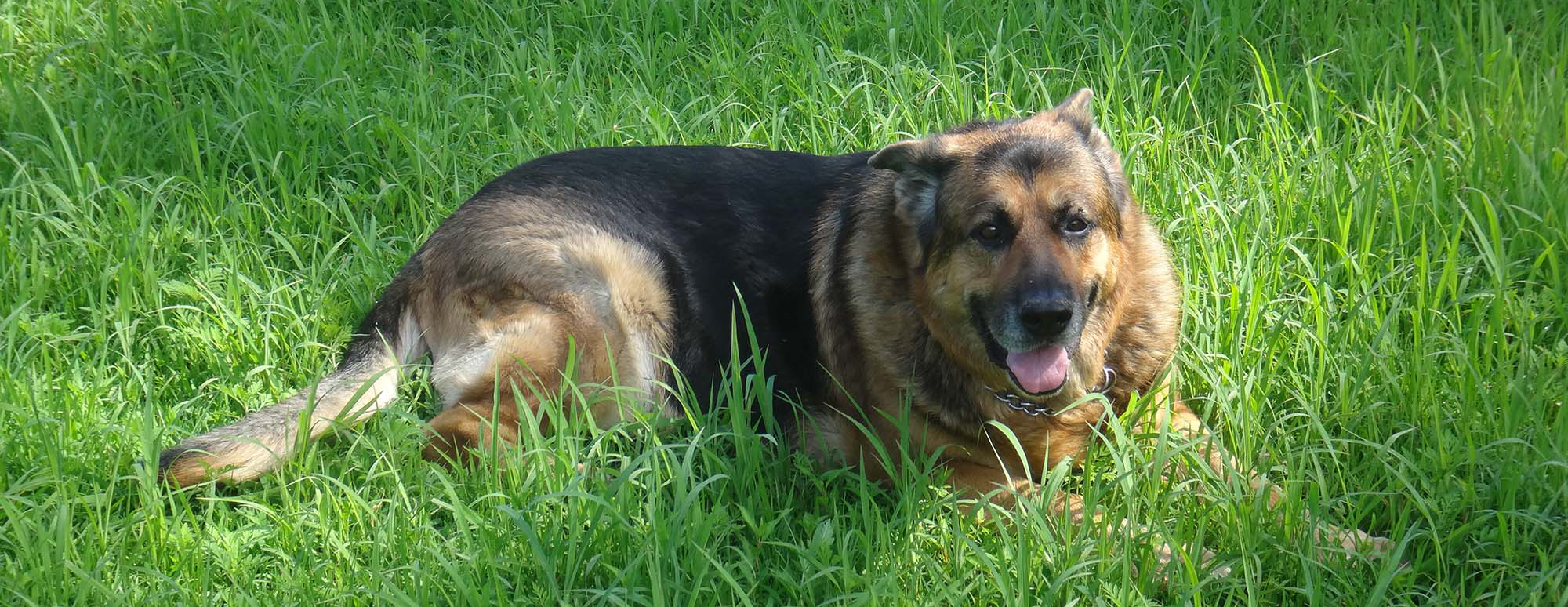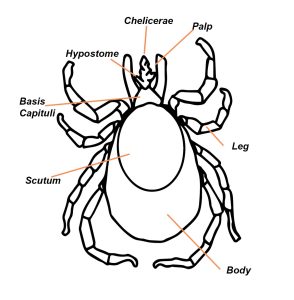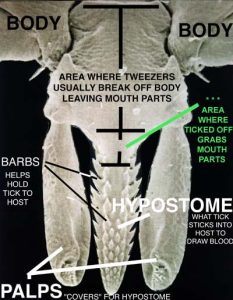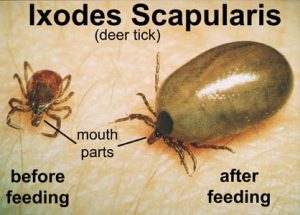Tick Facts & Fiction
Everything you ever wanted to know about ticks
(and maybe some things you didn’t 😉 )
Myths About Ticks
Myth: Ticks “burrow under the skin”
Truth: No they do not. Ticks only insert their hypostome (1/8″)
Myth: Ticks fly, jump or drop from trees.
Truth: They actually do not. They wait on the end of a tall blade of grass or twig for an animal to go by. Then crawl up and find a place to attach and feed.
Myth: Use of petroleum jelly, nail polish, alcohol, hot match, etc… helps the tick back out.
Truth: It has been scientifically proven in clinical research that this does not happen. Ticks will activate their defenses and regurgitate infected fluids into YOU, potentially giving you a disease. – DO NOT USE THESE!!
Myth: If the tick’s “head” breaks off in the skin, another tick will grow from it.
Truth: ABSOLUTELY NOT. An infection will result much like a splinter, and will work its way out of the skin over time.
Myth: “Getting Lyme Disease won’t happen to me”
Truth: Yes, it very well may. Lyme Disease is the second fastest growing infectious vector-borne disease in the United States. AIDS is number one. Never mind ALL the other diseases ticks transmit.
Myth: Rotating the tick will release it from the skin.
Truth: Ticks have barbs on the hypostome, NOT THREADS… you cannot unscrew a tick.
Myth: “Hard” ticks are small and “soft” ticks are big.
Truth: Hard ticks have a scutum or “shield-like” plate on their back. Soft ticks have no scutum. Most ticks are hard ticks.
12 More Facts About Ticks
- Ticks find a blade of grass of bush and climb up and wait… and wait… and wait… until a host comes by.
- Ticks find a host by sensing their breath (CO2), heat, as well as vibration using sense organs located on their front legs. Most ticks do have eyes, but, they do not see very well.
- Ticks will reach out with their legs and grab onto an animal’s fur or human’s clothing as they go by.
- The tick finds its way to a suitable place on the skin. Once there, it uses its chelicerae to slice a hole in the skin – you feel no pain when a tick bites you.
- The tick inserts its hypostome into the slice. As it does this, the tick excretes tick cement around the hypostome to help hold itself in place. This material looks just like skin.
- The tick draws its bloodmeal for about 30 – 72 hours, expanding in size as if feeds.
The female tick will then mate. - When you see two ticks “feeding together”, and one is smaller (male) on top of the other (female), the female is feeding and the male is waiting for her to finish and will then mate with her.
- After mating, the female tick will lay thousands of eggs (1,000 to 23,000 eggs… hopefully not near your house) … and begin the cycle again.
- You can tell a larval (seed) tick from an adult tick by their number of legs: larval ticks have 6 legs; nymphs and adult ticks have 8 legs.
- Ticks can live for months, even years without feeding. Average age of an adult tick is 2 years; oldest known tick is 35 years old.
- Ticks breathe only 3 – 5 times per hour, so forget about trying to smother a tick with vaseline, nail polish remover, alcohol, etc, ….. it won’t happen.
- Using a lit cigarette or cigar, hot match, or other like method will only aggravate the tick, and may cause it to burst or force tick fluids into you, maybe transmitting a disease to you.
What to Do After
a Tick Bite
Once you’ve removed the tick, what should you do next?
Diseases Transmitted
by Ticks
It’s more than just Lyme Disease.
Symptoms of
Tickborne Illness
Know the warning signs.
Identifying Different
Ticks
Know your enemy.
Tick Glossary
-
BLOODMEAL
When a tick feeds, sucking blood from a host.
-
CHELICERAE
A knife-like tool at the end of the hypostome that a tick uses to slice a hole in the host’s skin.
-
FEEDING: Bloodmeal (see above)
-
HOST
The animal or person a tick attaches to.
-
HYPSTOME
A harpoon-like tool a tick inserts into the skin, which allows it to suck blood fro the host.
-
PALPS
A sheath that protects a tick’s hypostome.
-
TICK CEMENT
A flesh-like looking material a tick excretes to help hold itself in place on the host. -
TICK HEAD
A tick’s mouthparts, which consist of the hypostome, chelicerai and palps.
What Happy (and Tick-Free) Customers Have to Say:




